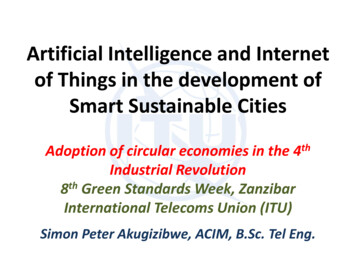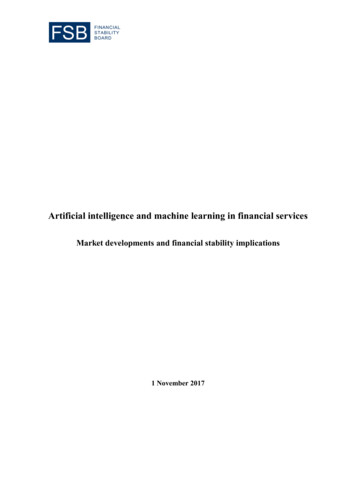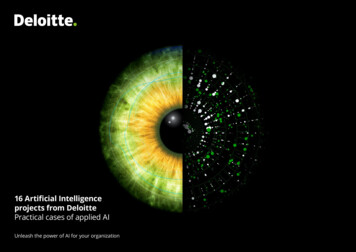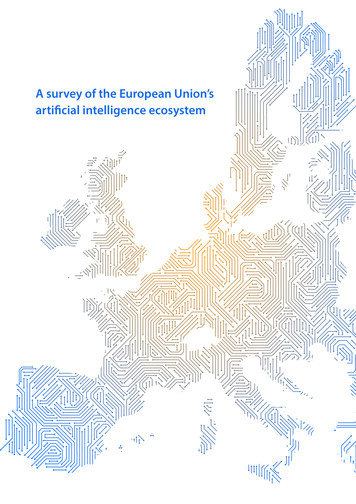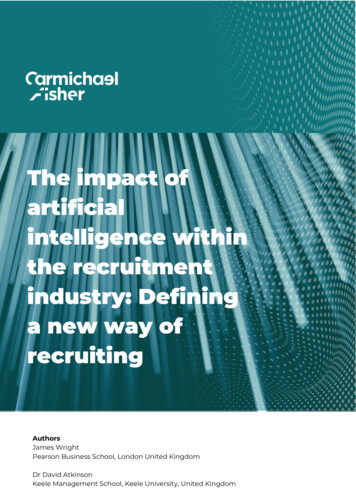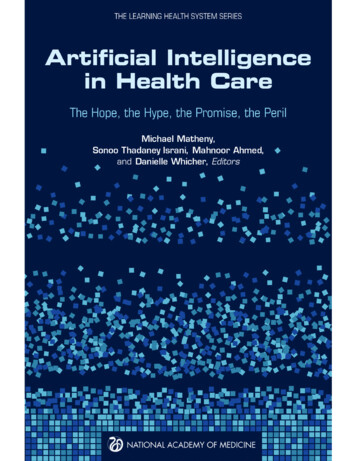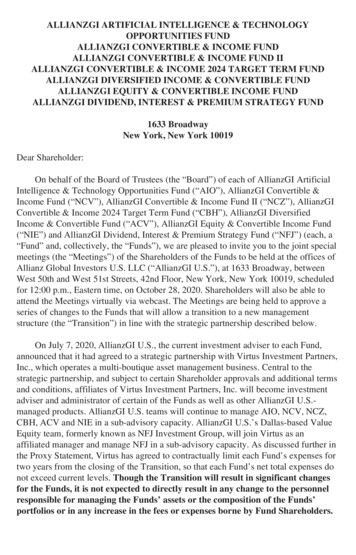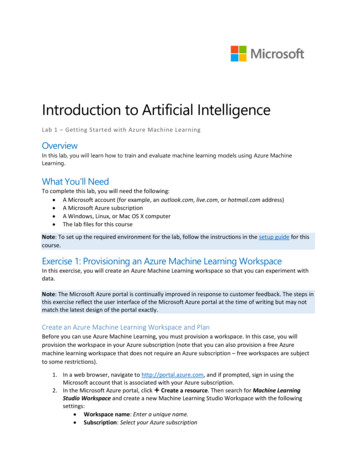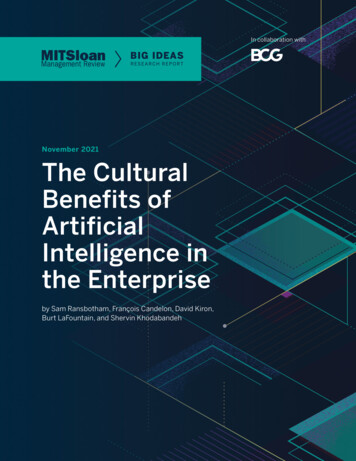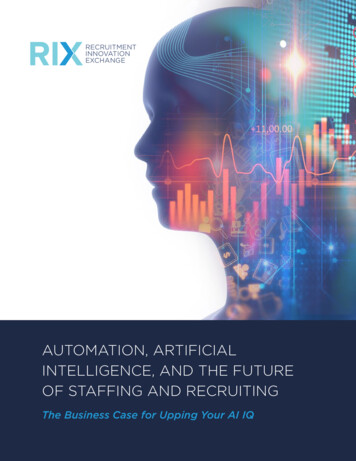
Transcription
BullhornRECRUITMENTINNOVATIONEXCHANGEAUTOMATION, ARTIFICIALINTELLIGENCE, AND THE FUTUREOF STAFFING AND RECRUITINGThe Business Case for Upping Your AI htBullhorndarkby
INTRODUCTIONGetting up to Speed on the ArtificialIntelligence (AI) LandscapeIt’s hard to avoid the headlines—and marketing campaigns—promising a business revolution driven by artificial intelligence.Despite the saying that “AI is no match for natural stupidity,” staffingfirms are by necessity getting smarter about applying AI (or moreaccurately, automation) to their business models.AI may be the buzzword du jour, but a longand complex path lies ahead. In fact, AI andAarelated concepts feature prominently onGartner Inc.’s 2016 Hype Cycle for EmergingDECONSTRUCTINGTechnologies—especially in the “Peak ofTHE LEXICON:Inflated Expectations” phase.1 It doesn’thelp that many people confuse automationCheck out the AI andand machine learning—characterized by dataAutomation glossarysets and algorithms—with true artificialintelligence—the capacity for machines toon page 4proactively and independently make decisions.To parse out the reality from the hype, enterprise staffing agencieshoping to drive efficiency and engagement through automation andAI must closely track the ecosystem. To that end, we’re taking a closerlook at use cases within the staffing and recruiting industry. In thiswhite paper, we set out to explore the following questions:What’s the difference betweenautomation and artificial intelligence?Where does the industry lie on the maturitycurve for adopting these technologies?What’s the dynamic between human andautomated elements of your workflow?What should firms be doing now to reducebarriers and promote adoption in their business?2
The AI Spectrum for Staffing FirmsAutomation is as ubiquitous as the email you get letting youknow your meal delivery kit is on the way or a text alerting you tosuspicious activity on your credit card. On the other end of thespectrum, AI is most dramatically embodied by the sentienthumanoid robot whose intentions are both unprogrammable andunknowable. In between lies a huge grey area characterized bychatbots, predictive algorithms, Siri, Alexa, and self-driving cars.A linear progression exists between automation and AI, and ourindustry falls somewhere near the front end of that progression.We’ve broken down the spectrum related to staffing into fourphases to better illustrate the technology landscape and wheretrue innovation is taking place.The AI Spectrum for Staffing FirmsARTIFICIALINTELLIGENCEPrevalent andproductivity-focusedFuture-state andtheoreticalAUTOMATIONWidespread interestUbiquitous andoften unseen“While thesetechnologies mightnot redefine what itmeans to ‘think,’ theyare starting to performactivities long thoughtto be the sole purviewof humans-sometimesat higher levels ofperformance thanpeople can achieve.”4Widespread adoption“Automation ispropelling the staffingindustry forward. Bybuying into a platformthat enables innovationand automation, firmscan gradually integrateautomation capabilitiesthat will help increasetheir efficiency anddrive furtherengagement.”2Matt FischerBullhorn3AI-INSPIREDAUTOMATIONNicolause Henke et alMcKinsey Global InstituteMACHINE ANDDEEP LEARNINGUncommon andcutting-edgeLimited investment“The application of deeplearning to business isstill relatively nascent.Academics andresearchers havedeveloped many of theplatforms, which arecurrently not businessuser-friendly. Those thatare take a considerabletime and effort to‘train’ with data.”3Brandon Purcell & RowanCurran, ForresterPurely hypothetical“Given the amount ofnecessary time andtraining to make AIfunction properly, pureAI is still a long wayoff. We are still verymuch in the early daysof this phenomenon,and the technologiesand use cases are atthe beginning of avery long evolutionarytrajectory.”5Brandon Purcell & RowanCurran, Forrester
AI AND AUTOMATION GLOSSARYA quick guide to common terms and tools.ALGORITHMNATURAL LANGUAGE GENERATIONAn algorithm is a specific set of mathematical oroperational instructions that determines how acomputer program analyzes and uses data toaccomplish a task or solve a problem.NLG technology transforms data intounderstandable written or spoken language.NLG is used to develop conversation agentsthat mimic humans as well as otherautomatically-generated content.ARTIFICIAL INTELLIGENCE (AI)Artificial intelligence is the theory anddevelopment of computer systems that canindependently perform tasks that normallyrequire human intelligence, including the abilityto reason, discover meaning, generalize, andlearn from past experience.NATURAL LANGUAGE PROCESSING (NLP)NLP technology lets computers understandhuman languages as they are spoken.Applications include language translation,speech recognition, and text recognition.PREDICTIVE ANALYTICSBOTA bot (short for “robot”) is an automatedprogram that runs over the Internet, eitherautomatically or in response to specific input.Common examples include web crawlers, chatbots, and malicious bots.ROBOTIC PROCESS AUTOMATION (RPA)Computer programs that conduct conversationswith humans, chatbots simulate how humanswould behave via natural language processing.RPA technology allows computer softwareor a “robot” to capture and interpret existingapplications for processing a transaction,manipulating data, triggering responses andcommunicating with other digital systems.DEEP LEARNINGVIRTUAL PERSONAL ASSISTANT (VPA)A branch of machine learning, deep learninguses neural networks that mimic theinterconnected neurons within the humanbrain. Deep learning platforms are used to solveproblems of pattern recognition and automationacross very large and complex data sets.Also known as a digital assistant, a VPA usesnatural language processing capabilities tocomplete electronic tasks that might havepreviously been handled by a human assistant.CHATBOTMACHINE LEARNINGMachine learning is the process through whicha computer system gets better at identifyingpatterns, associations, and insights throughexposure to “experiences” (training data)rather than by being explicitly programmed.4An application of machine learning, this termrefers to the act of analyzing current and pastdata to look for patterns that can improvepredictions about future events or performance.
THE PHASES OFTHE SPECTRUMAUTOMATIONUbiquitous and often unseen“What many people think of as artificialintelligence and machine learning is actuallyautomation,” according to Bullhorn Founder andCEO Art Papas. “The concept and technologiesbehind automation are not new, but staffingfirms are just now getting better and better atleveraging the technology that others havebuilt.” That technology has very real implicationsfor recruiting and every other industry, soonerthan later.At its core, automation involves minimizing humanintervention and relies on discrete triggers: if Xactivity happens, deliver Y response. Withinthe recruiting industry, much of the action inautomation lies in pragmatic tools, such asreplies to job applicants and parsing of onlineapplications. Often this automation istransparent to the end user, whether that isthe candidate or the recruiter themselves.Moving Data with BotsBots aren’t just for chatting. According to Harvey Nash’s Group IT Director Gavin Wilkins, “Wewant to develop bots to fundamentally move data between databases so that we don’t haveclunky processes requiring administrators to oversee them. For example, moving a contractorfrom placement to timesheet processing and then to a managed sevice and finally tooffboarding.” 6 Similarly, Cielo’s Vice President of Global Technology SolutionsAdam Godson touts the value of robotic process automation (RPA) to performrepetitive data transfer, such as when a hard integration with a client’s HRISplatform isn’t possible.5
AI-INSPIRED AUTOMATIONPrevalent and productivity-focusedWe’re still talking about automation, but nowwe’re edging into the space where functionalitymimics human interactions or assumes routine andtime-consuming recruiting tasks. Many of thesetechnologies take on a “flavor” of AI while utilizingdata and analytics capabilities. Think of a chatbotthat screens candidates for eligibility to work inthe U.S. or availability for different shifts.Example: The Virtual Personal Assistant“Who couldn’t use a recruiting assistant to help with scheduling andresponding to basic inquiries?” asks Art Papas. “Until now, it hasn’t beencost-effective.” Another example: Cielo has automated scheduling ofapproximately 50,000 phone screens a monthacross its network by allowing candidates toself-schedule interviews.6In the near term, look for basic automatedoutreach and engagement tools—such assearch and match, initial screening, andscheduling—to become table stakes in theindustry. “We’re still in the early adopterphase but the interest is tremendous. There’sclearly a need for this and a huge appetite togive it a shot,” says Eyal Grayevsky CEO andCo-founder of Mya Systems, the firm behindthe development of “your team’s A.I. recruiter.”
MACHINE AND DEEP LEARNINGUncommon and cutting-edgeMachine learning—the ability for computers“Anything that automatesto “learn” from data—lies at the heart of AIrepetitive tasks adds valuefunctionality. Deep learning is an extension ofmachine learning that leverages neural networkalgorithms, which mimic brain neurons. Machinelearning detects patterns and delivers hiddeninsights, such as personalized shoppingrecommendations and at-risk credit applications.In the recruiting world, machine learning isright away. When you’redoing predictive work,adding value in a waythat’s repeatable acrossdifferent clients is morechallenging.”being used to optimize client and candidateinteractions across channels by processing Summer Husband,massive amounts of data and informing actionSenior Director, Data Sciencein real-time. The applications are sophisticatedat Randstad Sourcerightand varied, and include back-end predictiveanalytics to evaluate pipeline profitability andfront-end conversational experiences basedon natural language learning.Survival AnalysisRandstad Sourceright is using survival analysis to test the applicability of machine learningtechniques to profitability analysis and resource allocation. The term comes from medicalresearch and predictions of how likely a patient is to be alive at incremental points afterdiagnosis, based on various factors. Replace “patient” with “open job” and you can seewhy the strategy can be used to evaluate recruiting risks.7
ARTIFICIAL INTELLIGENCEFuture-state and theoreticalAccording to Forrester research, “Given theamount of necessary time and training to makeAI function properly, pure AI is still a long wayoff.”7. There’s some debate about semantics andwhether being able to make predictions usingmachine learning constitutes AI.8 However, theholy grail of true artificial intelligence assignsthe capacity for machines to proactively andindependently exhibit intelligence.Stephen Hawking famously predicted that “Ithink the development of full artificial intelligencecould spell the end of the human race.”9 Earlierthis year, he, Elon Musk, Google’s Demis Hassabis,and other leading AI researchers and ethicistspledged support for principles to protect mankindfrom machines and a potential AI arms race.10For the foreseeable future, we’re more likelyto be discussing whether robots will take overstaffing jobs than whether they’ll take overthe world.8
LIMITATIONS ANDCHALLENGESIt should be obvious, but applying advanced machinelearning to recruiting is not easy to do, nor is it costeffective at the average staffing firm’s scale. ZDNetcontributor George Anadiotis explains why this“operationalization” of data science is so difficult: “Inmodern organizations, there is an abundance of datasources with varying degrees of reliability, these sourcesmay contradict each other, and the size and ingestionrate are also on a different level.”11Summer Husband of Randstad Sourceright knows that all toowell: “As we build out our machine learning capability, we’reconstantly working to bring visibility to the data. We havea lot of data coming from different sources that we have tofigure out how to fit together.”In the article “Artificial intelligence in the real world:What can it actually do?” Steven Hillion, Chief ProductOfficer at Alpine Data Labs, suggests that getting value outof automation lies as much in solving mundane data issues asit is in working with complex algorithms.12A Job-Centric EnvironmentIn staffing, practical challenges are exacerbated by the“outdated” notion of searching for a job or candidate, insteadof results based on data and past behavior, according to FelixWetzel, Managing Director at zyx associates.13GE’s Global Employment Brand Leader Shaunda Zilichagrees: “All the processes, tools, and technologies are set uparound jobs instead of candidates. There’s an opportunity toshift to a university mindset, where a candidate is acceptedbased on their match to a company’s culture and then theyare plugged in where the work needs to be done.”9
Privacy-Based RoadblocksA McKinsey Group Institute report on The Age of Analytics notes that “.the quantity andrichness of data collected on candidates is quite limited; the typical individual has farfewer interactions in the labor market than they do on social media or in the course ofonline shopping. This potential of machine learning in the labor market could beconstrained by this factor.”14Art Papas concurs, “People are getting less willing to disclose what they’re actually doingon social sites.” He adds that privacy concerns may outpace innovation: “Privacy is goingto beat automation. As automation increases, so will regulation to prevent you from usingit to its full capacity.”These issues are already impacting the recruiting industry;consider the General Data Protection Regulation (GDPR)taking effect next year for European Union citizens.Navigating opt-in requirements for candidate consentrequires the compliant collection, maintenance, andretention of data, which many firms aren’t prepared forat this time. As Tania Bowers, General Counsel of APSCoexplained in a Bullhorn forum, “It’s easy for people to askfor a GDPR statement, but you can’t get anywhere nearthat until you know your data.”1510
THE HUMANTOUCHManaging the interplay between human andautomated elements of the recruiting cycleposes specific challenges. According toAccenture research, “Since AI is a form ofvirtual labor, it will interact with the workforce,contributing and adding value in the same waya human co-worker would. To fully exploit thepotential of AI, human and machine intelligencemust be tightly interwoven.”16Determining when and where to insert automatedtouchpoints into a largely human process—andvice versa—takes deliberate process engineeringand follow-up. According to Adam Godson atCielo, “Not everything should be automated. Weautomate where we intentionally want to, andthen we insert intentional human touchpoints into get the job done more effectively.” The firmuses throughput measurement and webanalytics to measure drop-off rates associatedwith automated tasks.Recruiters Must AdaptGiven that a majority of millennials would preferto use chat technology vs. calling or emailing acompany, the risks of disintermediating humanrecruiters may be overstated. However, as GerardHughes of Peoplebank says, “Recruitment involvesemotion and empathy; machines cannot replacethis. Technology can help us locate the correctpeople, but it cannot replace the value of humanconnections.”1711
Art Papas seconds the notion: “What AI cannot and never will be able to do is predictif someone is willing to take a chance on hiring someone who doesn’t have the specificexperience listed as a requirement.” The human component of recruiting will never goaway. but it will change.“The future of talent acquisition looks like a combination of branding plus data thatfunnels someone to the role they should be in. At that point, the recruiter takes on moreof a career coaching role through the candidate’s entire journey,” according to GE’sShaunda Zilich. Recruiters who used to spend half their time making calls and lookingat resumes will now be expected to build deeper relationships. Those firms who are themost aggressive in transforming their workforce will have the most success.FRIEND OR FOE?So how much will automation change the daily experience of recruiting? Recruitersspend an inordinate amount of time on non-value-added, transactional tasks. This isespecially true for recruiters working on VMS accounts, whom Bullhorn estimates spendmore than 50 percent of their available time on non- revenue generating activities, andonly one-fifth of their time actually connecting with candidates.18The value of automation for recruiting efficiency can’t be overstated, according to MyaSystems’ Eyal Grayevsky. “If we can solve for bottlenecks by automating the repetitive,routine work, we can enable recruiters to be more effective and focus on moremeaningful interactions,” he indicates.“The impact is tremendous, especiallywith high volume scenarios. If you canautomate the first two or three stepsof the process instantaneously whileenhancing the experience and quality,it’s a no brainer.”12
Prepare, Don’t PanicThat analysis aligns with the opinions of recruitingprofessionals who believe automation will helpto promote (not eliminate) top talent. RecentBullhorn research found that 67% of staffing leaders were eager to relinquish non-valueadding tasks such as scheduling and screeningso they can grow their relationships.19“AI can help you see things that a human can’t,so it can make the eventual conversations withhumans more productive,” says Summer Husband.“This is the future,” adds Cielo’s Adam Godson.“Recruiters who are rock stars and constantlyseek to add value are unafraid of automation.”The Case for DiversificationInstead of worrying about whether automation will make recruiting jobs go away, worryabout whether it will make your clients obsolete. “Enterprise staffing firms need to thinkabout where their business comes from. Are you servicing industries that could be automatedentirely, such as truck drivers, payroll clerks, or light industrial? Don’t overlook the obvious;that’s where the impact is going to be,” say Bullhorn Founder & CEO Art Papas.13
EXTERNAL VALUEIn addition to the low-hanging fruit of reducing recruiting grunt work, automation holdspractical implications for client delivery and candidate engagement. Felix Wetzel argues thatthe impact has not been all positive: “The combination of the two—well-matched [search]results thrown at humans faster—has resulted in a deteriorating customer and candidateexperience.”20In contrast, most of the industry leaders we spoke to are focusing on the upside. Forexample, when search and match technology improves upon the limits of human-createdsearch strings, candidates have a better shot at being “discovered.” Eyal Grayevsky notes,“Because of the size of the data set that we are able to aggregate and analyze, AI cansurface candidate insights and predictors of performance that enable recruiters to makebetter hiring decisions.”Boosting Candidate EngagementAutomation tools may actually increase candidate satisfaction with the recruiting process byproviding more responsive feedback loops and identifying other potential openings that maybe of interest. Every interaction fills in a piece of the puzzle for better results, not only forimmediate recruiting needs but for long-term loyalty-building programs.Staffing and Recruiting Client ImpactGiven that a majority of millennials would prefer Clients also benefit from AI-driveninnovation. “Its real potential from a business perspective lies in its ability to unlock insightfrom data to influence smarter decision making,” says Bullhorn’s International ManagingDirector Peter Linas
replies to job applicants and parsing of online applications. Often this automation is transparent to the end user, whether that is . from placement to timesheet processing and then to a managed sevice and finally to . Randstad Sourceright is using surviv
